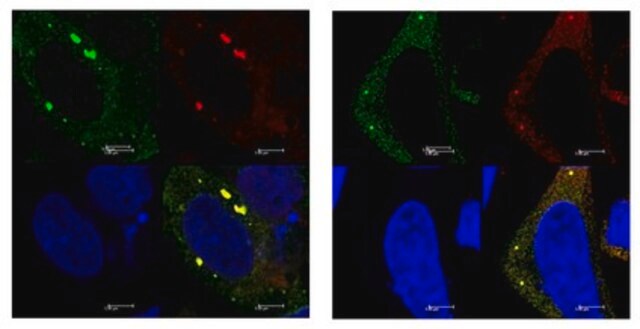ABS2082
Anti-PDH
serum, from rabbit
Synonyme(s) :
Pyruvate dehydrogenase E1 component subunit alpha, somatic form, mitochondrial, PDHE1-A type I, Pyruvate dehydrogenase E1 component subunit beta, mitochondrial, PDHE1-B
About This Item
Produits recommandés
Source biologique
rabbit
Niveau de qualité
Forme d'anticorps
serum
Type de produit anticorps
primary antibodies
Clone
polyclonal
Espèces réactives
mouse, human
Technique(s)
immunocytochemistry: suitable
immunofluorescence: suitable
immunohistochemistry: suitable
western blot: suitable
Conditions d'expédition
dry ice
Modification post-traductionnelle de la cible
unmodified
Informations sur le gène
human ... PDHA1(5160)
Description générale
Spécificité
Immunogène
Application
Western Blotting Analysis: A 1:4,000 dilution from a representative lot detected endogenous PDH alpha and beta subunits in 50 µg of mouse liver tissue lysate as well as 50 ng of purified recombinant human PDH alpha and beta subunits (Courtesy of Professor Mulchand S. Patel, Ph.D., SUNY Buffalo, NY, U.S.A).
Immunofluorescence Analysis: A representative lot immunostained oocytes in Bouins fluid-fixed, paraffin-embedded sections of mouse ovaries. A loss of oocyte PDH immunostaining was observed in ovaries from transgenic mice carrying homozygous floxed Pdha1 alleles and zona pellucida protein-3 (Zp3) promoter-driven Cre expression to allow oocyte-specific Pdha1 deletion (Johnson, M.T., et al. (2007). Biol Reprod. 77(1):2-8)
Immunohistochemistry Analysis: A representative lot immunostained neural cells in paraplast-embedded brain microtome sections from Bouins fluid-perfused mice. A marked increase in cells with low PDH immunostaining was observed in brain from transgenic mice carrying heterozygous floxed Pdha1 allele and nestin promoter-driven Cre expression to allow brain tissue-specific Pdha1 deletion (Pliss, L., et al. (2004). Neurochem. 91(5):1082-1091).
Western Blotting Analysis: A representative lot detected reduced level of PDH alpha & beta subunits in brain, but not liver, tissue from transgenic mice carrying heterozygous floxed Pdha1 allele and nestin promoter-driven Cre expression to allow brain tissue-specific Pdha1 deletion (Pliss, L., et al. (2004). Neurochem. 91(5):1082-1091).
Signaling
Qualité
Western Blotting Analysis: A 1:2,000 dilution of this antibody detected PDH alpha and beta subunits in 10 µg of human whole brain tissue lysate.
Description de la cible
Forme physique
Stockage et stabilité
Handling Recommendations: Upon receipt and prior to removing the cap, centrifuge the vial and gently mix the solution. Aliquot into microcentrifuge tubes and store at -20°C. Avoid repeated freeze/thaw cycles, which may damage IgG and affect product performance.
Autres remarques
Clause de non-responsabilité
Vous ne trouvez pas le bon produit ?
Essayez notre Outil de sélection de produits.
Code de la classe de stockage
12 - Non Combustible Liquids
Classe de danger pour l'eau (WGK)
WGK 1
Certificats d'analyse (COA)
Recherchez un Certificats d'analyse (COA) en saisissant le numéro de lot du produit. Les numéros de lot figurent sur l'étiquette du produit après les mots "Lot" ou "Batch".
Déjà en possession de ce produit ?
Retrouvez la documentation relative aux produits que vous avez récemment achetés dans la Bibliothèque de documents.
Notre équipe de scientifiques dispose d'une expérience dans tous les secteurs de la recherche, notamment en sciences de la vie, science des matériaux, synthèse chimique, chromatographie, analyse et dans de nombreux autres domaines..
Contacter notre Service technique